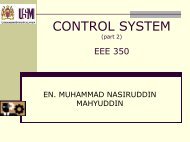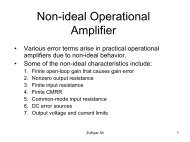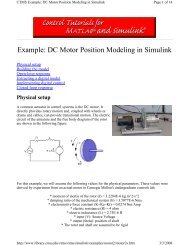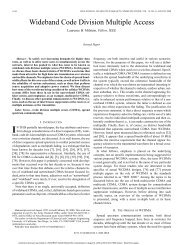Lecture notes - School Of Electrical & Electronic Engineering - USM
Lecture notes - School Of Electrical & Electronic Engineering - USM
Lecture notes - School Of Electrical & Electronic Engineering - USM
Create successful ePaper yourself
Turn your PDF publications into a flip-book with our unique Google optimized e-Paper software.
Thus, the system is not stable.<br />
1.3 Example 2<br />
By using RH criterion, determine the stability of a<br />
digital system whose CE is given as P (z) = z 3 +<br />
3.3z 2 + 3z + 0.8 = 0.<br />
1.3.1 Solution to Example 2<br />
Transforming the CE P (z) into w-domain by using<br />
bilinear transformation z = w+1<br />
w−1 , gives:<br />
8.1w 3 + 0.9w 2 − 0.9w − 0.1 = 0 (3)<br />
The RH tabulation for the transformed CE 3 is as<br />
follows:<br />
w 3 8.1 -0.9<br />
w 2 0.9 -0.1<br />
w 1 0 0<br />
w 0<br />
The routh test could not be continued in the usual<br />
manner since row w 1 contains all zeros. The tabulation<br />
is proceeded by the auxillary equation from the<br />
coeffecients in the w 2 row:<br />
A(w) = 0.9w 2 − 0.1 = 0 (4)<br />
Taking the derivative of A(w) in equation 4 with<br />
respect to w , gives:<br />
A(w)<br />
dw<br />
= 1.8w (5)<br />
The coeffecient in the w 1 row are then filled with<br />
A(w)<br />
the coeffecient of<br />
dw<br />
, and the Routh tabulation<br />
then becomes:<br />
w 3 8.1 -0.9<br />
w 2 0.9 -0.1<br />
w 1 1.8 0<br />
w 0 -0.1<br />
From the Routh table, it can be see that there is<br />
one sign change, which implies that the CE has one<br />
root in the right half of the w-plane, or P (z) has one<br />
root outside the unit circle in the z-plane.<br />
1.4 Example 3<br />
By using Routh-Hurwitz stability criterion, determine<br />
the range of the gain K and the sampling period<br />
T, so that the digital system whose CE is given as<br />
P (z) = z 3 + a 2 z 2 + a 1 z + a 0 is asymptotically stable.<br />
The coeffecients of the CE are as follows:<br />
a 2 = 111.6T 2 + 16.74T − 3 (6)<br />
a 1 = 1.395 ∗ 10 −4 KT 3 − 33.48T + 3 (7)<br />
a 0 = 1.395 ∗ 10 −4 KT 3<br />
− 16.74T − 111.6T 3 − 1 (8)<br />
1.4.1 Solution to example 3<br />
Transforming the CE P(z) into w-domain by using<br />
the bilinear transformation z = w+1<br />
w−1 , gives<br />
where,<br />
A 3 w 3 + A 2 w 2 + A 1 w + A 0 = 0, (9)<br />
A 3 = a 2 + a 1 + a 0 + 1 = 2.79 ∗ 10 −4 KT 3 (10)<br />
A 2 = a 2 − a 1 + 3a 0 + 3 = 446.4T 2<br />
− 5.58 ∗ 10 −4 KT 3 (11)<br />
A 1 = −446.4T 2 + 66.96T<br />
+ 2.79 ∗ 10 −4 KT 3 (12)<br />
A 0 = −a 2 + a 1 − a 0 + 1 = 8 − 66.96T (13)<br />
2
















